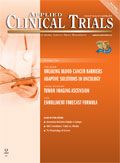Congress, White House Seek to Spur Biomedical Innovation
Applied Clinical Trials
The productivity of the U.S. biomedical research enterprise is undergoing a broad re-examination.
The productivity and efficiency of the U.S. biomedical research enterprise is undergoing a broad re-examination that includes assessment of how FDA regulation serves to bring-or block-new medicines from the market. FDA policies for developing new medical technology are considered in President Obama's "Precision Medicine Initiative," a $215 million program to create a massive database of patient genomic information to stimulate biomedical research. While the program focuses on initiatives by the National Institutes of Health (NIH) to identify genomic factors important in developing effective treatments for cancer and other diseases, FDA is charged with devising strategies that will encourage innovation related to next generation sequencing (NGS) technologies.
FDA recognizes the importance of NGS systems for identifying critical genetic variants, but also wants to assure that tests are accurate, reliable, and clinically relevant. Access to broader patient genomic information promises to help identify individuals for targeted clinical trials, along with other techniques for evaluating new therapies for cancer and other serious conditions. The National Cancer Institute (NCI) is examining how genomics data could enable an "open clinical trials" system that enrolls patients who share targeted genetic lesions.
FDA examined strategies for regulating how NGS diagnostic tests should demonstrate analytic validity at a public workshop in February and in a discussion draft on the topic. The agency has approved limited "carrier" tests that screen for specific gene variants. A sign of increased regulatory flexibility is its recent approval of 23andMe's test for the rare Bloom syndrome under a streamlined review process, which may provide a model for authorizing additional NGS products.
Congressional incentives
Multiple proposals for revising FDA policies are included in the "21st Century Cures Act," a massive document unveiled in January by the House Energy & Commerce Committee. The package features patent and exclusivity provisions to encourage private sector investment in biomedical research and antibiotic development, along with measures to streamline clinical trial operations and reform oversight of medical devices.
Similarly, the Senate Health, Education, Labor and Pensions (HELP) Committee is examining FDA and NIH policies related to biomedical innovation, starting with a lengthy report from Republicans on FDA regulatory inefficiencies and outdated policies accused of delaying medical product development. The HELP panel launched a broad review of these issues last month with a hearing to gain input from NIH director Francis Collins and FDA commissioner Margaret Hamburg, probably her last appearance on Capitol Hill as FDA's leader. Hamburg announced in February that she would leave FDA at the end of March after six years on the job. Chief scientist Stephen Ostroff heads the agency pending action in the White House and Senate to nominate and confirm a new commissioner.
Meanwhile, enactment of any FDA reforms this year requires fast consensus on a few specific measures agreeable to both sides of the aisle, such as incentives for testing new antibiotics. Otherwise further FDA reform legislation will wait until 2016, when Congress will face a hard deadline in 2017 for authorizing the next round of FDA user fees.
Regulatory responses
Many of the Congressional provisions for stimulating biomedical R&D are not new and already are being implemented by FDA. For example, the agency stole the thunder from a House compassionate access proposal by unveiling in February a shorter and simpler form for physicians to seek access to investigational drugs for individual patients. Compassionate use advocates still criticized the change as "window dressing," but the FDA guidance appears to have softened charges that excess government regulation blocks patients from critical therapies.
FDA officials would like to do more to support development of biomarkers and innovative clinical research strategies, and additional resources would bolster such efforts. The Obama administration has proposed a small increase in FDA funding for 2016, but most new dollars for drugs and biologics comes from higher user fees. FDA officials thus are very wary of new legislation requiring additional reports and rules and creating new oversight programs-but without added money to finance those efforts.
Agency critics looking to streamline rules governing drug development and testing may be interested in the agency's latest calculation of the time spent by sponsors and investigators to comply with all the requirements for submitting forms and keeping records related to investigational new drug (IND) applications. The small print in a recent FDA Federal Register notice (March 3, 2015) indicates that IND reporting and recordkeeping for drugs and biologics adds up to 23 million hours a year. Submitting an IND for an investigational drug averages 1,600 hours-and with 2,600 "responses," that totals more than four million hours. An IND protocol amendment involves only 284 hours to submit, but there are more than 20,000 of them and thus requires more than six million hours to complete them all.

Newsletter
Stay current in clinical research with Applied Clinical Trials, providing expert insights, regulatory updates, and practical strategies for successful clinical trial design and execution.
FDA Issues Complete Response Letter to Replimune for RP1 Combination Therapy in Advanced Melanoma
July 22nd 2025The FDA’s complete response letter cited concerns that the Phase I/II IGNYTE (NCT03767348) trial in advanced melanoma was not an adequate, well-controlled study and that its heterogeneous patient population limited interpretability, preventing approval in its current form.
New FDA Initiative Reveals Common Reasons for Drug Application Rejection
July 11th 2025By publishing more than 200 complete response letters, the FDA is offering new visibility into the issues that most often delay drug approvals, including safety concerns, trial design flaws, and manufacturing gaps.